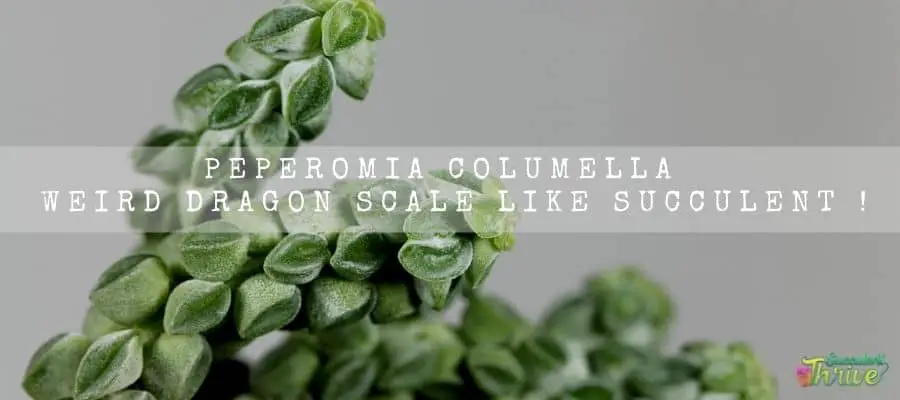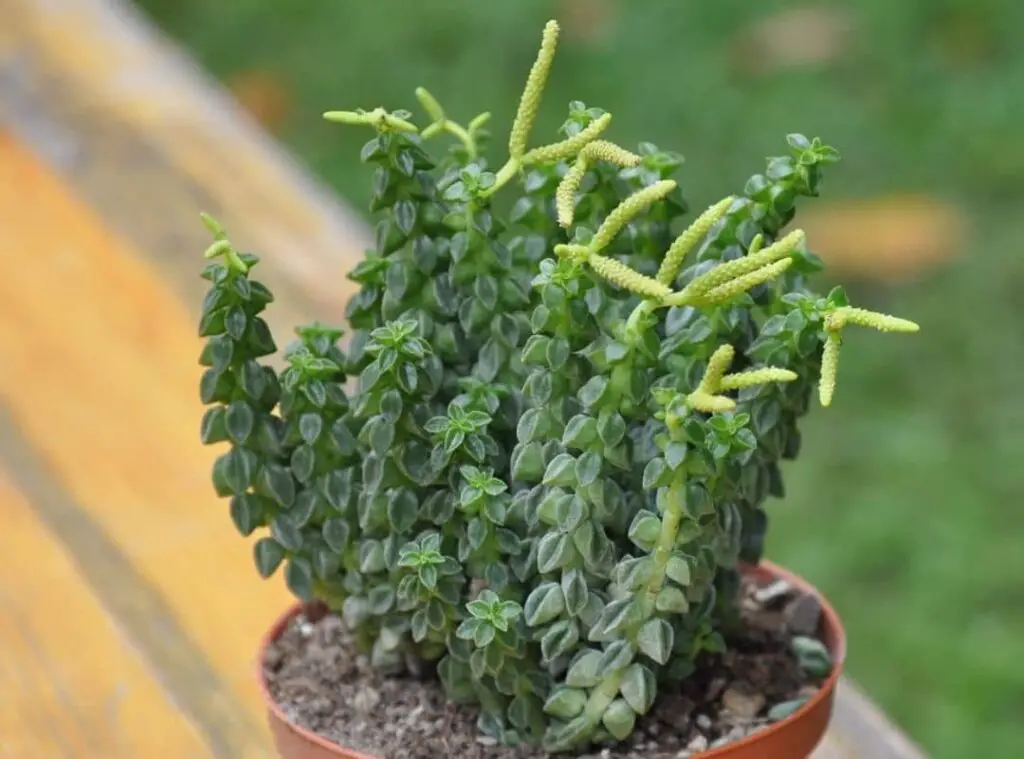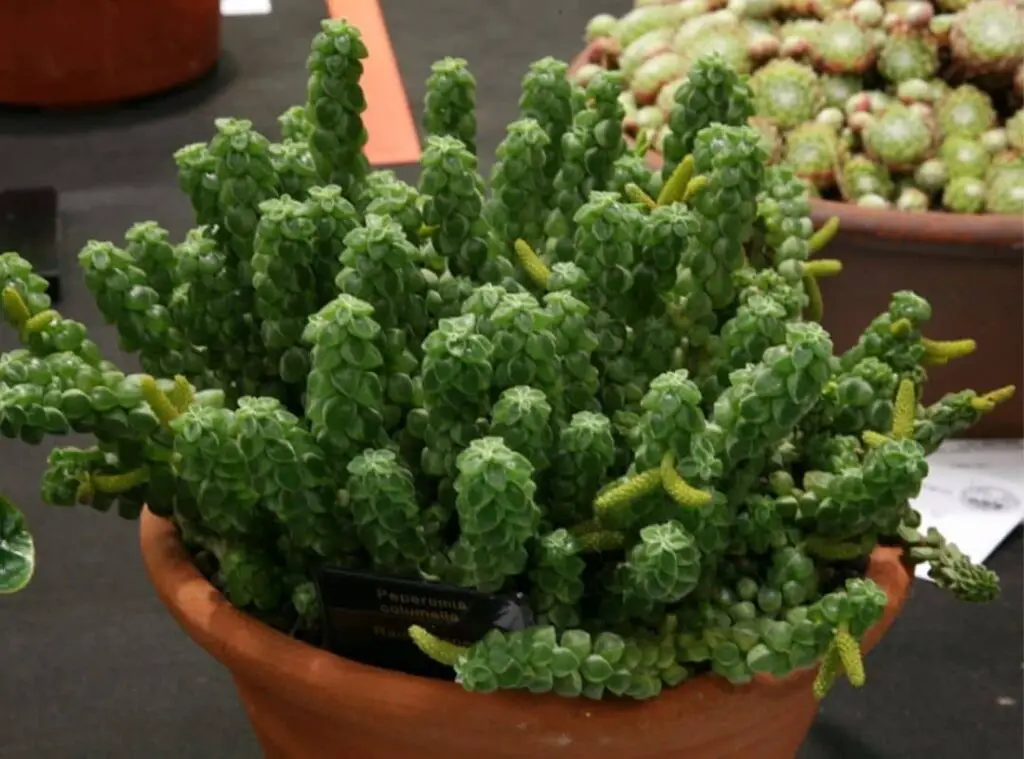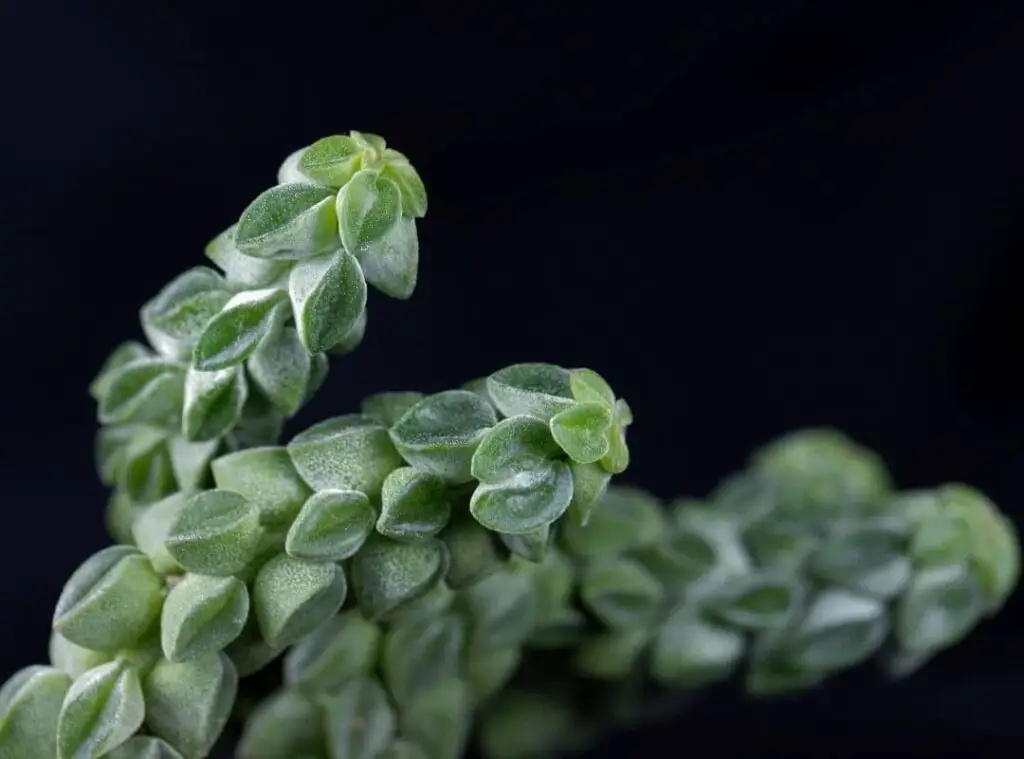Peperomia columella or pearly peperomia are fantastic houseplants native to South Africa and to Peru. You could spot them growing in tropical regions steep cliffs.
If you are a great succulent enthusiast, you should have one of these beauties in your succulent collection.
They would make such great additions for your terrarium as well. Peperomia columella is considered as an endangered plant species.
Peperomia columella have inherited their name as their leaves tend to grow closer to each other whilst hiding the stalk.
They would usually grow upright when they are immature and would tend to become a pendant as they grow. That characteristic makes them great additions for hanging baskets.
Peperomia columella requires easy maintenance from you. However, it is worth studying on all the growing requirements they want before you start off growing them. So, this article is about their right growing tips and on their propagation methods as well.

How do I identify Peperomia columella?
Peperomia columella have leaves which have a closer resemblance to dragon scales. Peperomia columella form shoots which look like snakes.
The leaves are chubby and thick, and they tend to look like horseshoes. In fact their leaves edges will form in a pointed manner where they will have a round shape in the center.
They produce flowers either in white or in green. Those blooms tend to take a tiny tail-like appearance, and they would arise from the top of the stems as well.
They would consist of a spadix which is in lime green color. Peperomia columella blooms do not carry any fragrance.
Peperomia columella leaves’ unique shape is quite crucial when absorbing light.
In terms of the sizes of the plants their stems are about 2 inches ( 5 cm ) – 7.8 inches ( 20 cm) tall . Further their width would be about 0.4 inches. They would take about 10 year’s time to grow to their full potential.
One look care guide
| Botanical Name | Peperomia columella |
| Common Name | Pearly peperomia |
| Plant Type | Succulent |
| Mature Size | Height of 15.7 inches ( 40 cm) Width 19.6 inches ( 50 cm) |
| Sun Exposure | Full sunlight to partial shade |
| Soil Type | Well-draining |
| Soil pH | Around 6-7. |
| Bloom Time | Spring |
| Flower Color | White or Green |
| Hardiness Zones | USDA hardiness zone 10 |
| Native Area | Peru South Africa |
| Toxicity | Non-Toxic |
| Average price | $ 18 |
How do you take care of Peperomia columella?
As aforesaid Peperomia columella take about one decade’s time to grow to their best potential. They are a climbing variety which grows as an epiphyte.
Having said that, they have a moderate growth rate too. Their leaves grow in a vining pattern.
Light Requirement
Natural sunlight would be ideal for the indoor grown Peperomia columella plants. Having said that they can thrive well with artificial lights also.
They are tolerant of full sunlight to semi shade. However filtered sunlight would be the most optimal conditions for them. If you keep exposing them to full sunlight for extended periods , it would male the plants scorched.
A brightly lit sunny spot would be a perfect location to place these plants.
If the plants lack sufficient sunlight levels, you could consider placing them near inflorescent lights. If you grow them outdoors, they can survive in partial sunlight.
Temperature and humidity
Peperomia columella plants are not picky when it comes to temperature. However, it would be better if you could grow them in places where there will be warmer temperatures.
Hence, they can thrive well in room temperature. The most appropriate temperature range for them would be 65- 80 degrees Fahrenheit. ( 18-27 degrees Celsius).
Peperomia columella plants are somewhat cold hardy too. Never expose them to temperatures below 41 degrees Fahrenheit (5 degrees Celsius) during winter.
When any colder weather is forecasted, you need to bring them indoors to protect the plants. Even when you place them indoors, refrain from placing them near air conditioners and radiators.
The right humidity levels for the Peperomia columella plants should be somewhat high. To be precise 60% – 90 % humidity level would work on them during daytime.
On the other hand, nighttime humidity level should be 70 % – 90 %. If you want to adjust the humidity levels, you may consider adding substances such as pebbles. Besides, you could keep the right humidity level by misting them.

Is it cold hardy?
Peperomia columella plants are a little cold hardy as aforesaid.
USDA Hardiness Zone
Peperomia columella plants are hardy in USDA hardiness zone 10.
Watering Requirement
Peperomia columella plants have moderate requirements in water. The rest of other Peperomia species have the same requirements.
I recommend you water them overhead without watering them at the bottom. These are drought tolerant plants which means they can thrive for some time without water.
As explained , when Peperomia columella plants run short of water, their matured leaves transfer their water into young plant leaves.
You need to be careful not to leave them exposed for waterlogged conditions particularly on a rain day. Ensure that you water them deeply during spring and autumn.
However, ensure that you are letting the excess water move through the draining holes after you finish watering them.
Always water them only if their soil is dry. However, do not let their soil become bone dry. When it comes to watering the plants in winter, ensure that you are supplying them only a minimum level of water.
Besides, ensure that you stick to a watering schedule also. The water you are using should be at room temperature.
Further you may consider misting them too. However, it is not compulsory to do, and you could do it only if there is dry weather around the plants only.
Soil Requirement Type / pH
The right soil mix to grow these plants would be a mix of peat, moss, perlite, charcoal humus and mulch. The ideal ph. should be around 6-7.
Besides, you could proceed with a standard cactus soil mix also. However, ensure that you add elements like perlite, pumice, or even grit to fasten the draining of the soil mix though.
Ensure that you are growing them in a fast draining soil mix to grow them. That will help to avoid any potential rot of the plants.
Pot size Potting and Repotting.
Ideal pot type to grow the Peperomia columella plants would be either clay pots or terracotta pots. That will ensure that the excess moisture in the pot evaporates faster.
When it comes to repotting, you could consider repotting them once every year prior to spring.
That will help the plants to grow vigorously and firmly.
However, when you report, you need to always select a slightly larger pot as if you grow them in excessively larger pots , it makes the plants drown.
Consequently, it will encourage root rot and other fungal infections also.

Where to Plant
They would be great picks to keep on the shelf, tables where their leaves can show off.
Additionally, a windowsill would also be a perfect place to grow them. You may either grow them as solitary plants or dish garden plants.
Fertilizer and time of year
Peperomia columella plants have minimal requirements in terms of the fertilizers. They can grow well whether you feed them or not.
However, a minimal feeding would be beneficial for the plant’s growth. If you are wondering what type of fertilizer would suit them, it should be ideally a cactus fertilizer which is diluted to half strength.
Once a month feeding during their growing season is more than adequate. Never feed them when they are dormant though.
Dormancy
Peperomia columella plants’ dormancy season is in winter.
Can be toxic to pets
There are no records of Peperomia columella plants toxicity to pets. Hence, you may consider them as nontoxic plants for pets.
Common bugs and illnesses
Mealybugs
Peperomia columella plants are resistant towards pests in general. However, chances are that they may go through pests attacks sometimes and mealybugs is one of them.
Mealybugs could be so annoying as they can go unnoticed for a longer period. In fact, they can hide in the small areas of the plants, and it is very unlikely you could spot them as their leaves are formed in a tight manner.
Best is to observe the plants and see whether there are any pests or bugs. In case if you come across any white substances, they could be most probably mealybugs.
At the very moment you spot any, you need to isolate the plants and treat them. That way you can stop further spread in the affected plants as well as among the rest of the plants in the garden.
To treat them, you may use rubbing alcohol and apply them at the damaged areas by using cotton balls.
Further, get rid of the damaged leaves and flowers entirely. Mealybugs could be so irritating as they could invade almost all the parts of the plants.
Hence, it would be better if you could spray the whole plant with soapy water or even with an insecticide spray to get rid of them entirely. You may consider using neem oil since it is organic and there will be no chemical damage to the plants.
Spider mites
Getting rid of spider mites completely may be a huge challenge as they can multiply rapidly. Hence it is critical that you attend to it as soon as possible.
You could spot the spider mites on the yellowed mottled leaves. Spider mites depend on the plant’s sap and they form webs underneath the leaves of the plants as well as on the flowers.
Hence you need to kill them at the very moment you spot them by simply crushing them. Further consider pruning the affected plants parts also.
If the spider mite attack is on a minor level, you could treat them with a damp cloth.
Besides, you may bring the plants to your bathroom and spray some soapy water. Next rinse the plants with water to remove them.
Let the plants dry for some time and next treat them with a chemical or with an organic pesticide. You may use neem oil to treat the spider mites attack also as it does not have any harmful effects.
It is affordable for anybody too. Continue repeating these actions to entirely get rid of them.
Water Stress
Peperomia columella plants are quite sensitive for over watering. When you provide excessive amounts of water for them, it will result in the plant’s leaves yellowing.
Besides, there will be stunt growth in the plants as well.
To remedy it, you need to suspend watering them for some time and adjust your watering schedule so that these issues will not reoccur.
In addition to correct watering practices, it is important that you grow them in a well-draining soil mix as these two factors go hand in hand.
Brown Leaves
Peperomia columella plants may form brown leaves due to under watering. Unfortunately, the best you could do here is to trim off the damaged leaves as it is very unlikely that they will become green.
Next, adjust the watering schedule properly so that the plants will not go through these issues again. If you are a forgetful gardener, you can keep a track on your calendar on the watering dates.
Excessive Sunlight
Peperomia columella plants used to grow in filtered light when they were in their natural habitats. Hence, if you expose them to bright direct sunlight, it will result in the scorching of the plants.
Gradually they will start to lose the green touch in the plants. To treat them, first and foremost, you need to move the plants to a shady place where they can gain partial sunlight.

Special Care tips
Peperomia columella plants need only minimal maintenance. However, you may consider pruning them to make them look aesthetically beautiful. When interacting with the plants, you need to wear protective gloves.
Never feed the plants right after you repot them. Ideally wait for about 1-2 months and then feed them if it is necessary.
Grow them in a spot where there is a good aeration which will be beneficial to avoid any fungal infection or a pest attack.
Besides, expose them for sufficient bright indirect sunlight when you grow them. Water them in moderate levels and do not over water them at any given time. Do not leave your plants closer to cold drafts, radiators as it would make the plants turn brown.
I encourage you to clean the plants on a constant basis. Unless dust particles will retain in the plants, and it will make disruptions for the light absorption for the plants.
Always water them with filtered water as they are quite responsive for chemicals such as chlorine, fluoride.
If you have no other option rather than using tap water, you could leave them in a water can for one or two days and the water.
That will allow all the chemicals to evaporate. Always try to water them in the morning hours. That will allow the plant to absorb water during the daytime and it will make the plants less prone for fungal attacks and bacterial infections as well.
How to propagate Peperomia columella.
You may use the stem cuttings of Peperomia columella plants to propagate them.
- First you need to arrange tools such as pruning shears and scissors, which are clean and sterile.
- You can wipe them with rubbing alcohol to disinfect them.
- It is vital that all the tools that you are using are disinfected so that it will not create any bacterial infections in the plants.
- If you end up using infected cuttings also , it is unlikely that you will have successful results of the propagation.
- First you need to take cuttings which have 3-4 inches in length.
- Further ensure that your cuttings have few healthy leaves on them as well.
- Ensure the cuttings you are using are from healthy plants.
- Next, you need to trim the bottom part of the cutting.
- After that, arrange a pot and fill some potting medium in the pot to half of the size of the pot.
- Next, dig a small hole in the pot and place the cuttings there.
- You need to bury the cuttings into a depth of at least 1-2 inches.
- Next add some more potting soil and compact the soil around the cuttings.
- Ensure that the lower leaves are not in contact with the soil layer.
- You may water them moderately in the pot now as it will make the soil mix saturated.
- Next, you can water them only if their soil is dry.
- Next, locate the specimen in a location where they can gain high humidity levels and bright sunlight as well.
- However, avoid exposing them for direct sunlight.
- A temperature range of 55-80 degrees Fahrenheit would suit them well during the propagation process.
- You need to propagate the Peperomia columella plants only in early spring.
- Do not propagate them in October to February.
- Further I recommend you use a few stem cuttings instead of having just one so that you can have guaranteed results.
Conclusion
Peperomia columella plants are such spectacular plants which usually form a unique foliage right throughout the year.
Their unique formation of leaves adds extra beauty for the plants. Their easy maintenance is one more advantage of having them. Happy cultivating with Peperomia columella plants !
Read Next : Peperomia Belly Button ( How To Take Care Of Them )
